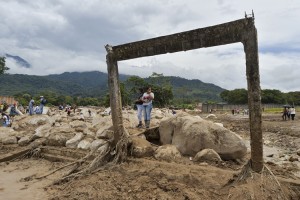Calamity in Colombia
April 3, 2017
In the early morning hours of Saturday, April 1, flooding and rocky mudslides engulfed parts of the city of Mocoa in mountainous southern Colombia. Mocoa is the capital of Putumayo, a department that runs along the border with Ecuador and Peru. Unusually heavy rains Friday night flooded the area’s Mocoa, Mulata, and Sangoyaco rivers. Steep ravines and gullies channeled the liquid mud and debris-filled water toward sleeping Mocoa. Entire homes disappeared and streets collapsed as boulders and fallen trees lodged against cars, washing machines, and shattered masonry wrenched away in the powerful torrent. The dead bodies of 301 people have been found, but more than 200 people remain missing.

Survivors contemplate the damage done by flooding and mudslides in the southern Colombian city of Mocoa on April 2, 2017. Credit: © Luis Robayo/AFP/Getty Images
Colombian President Juan Manuel Santos declared a state of emergency as he arrived in Mocoa. “The entire capacity of the state is deployed to support the search and rescue,” he said. “The tragedy of Mocoa hurts me as president and as a human being. My heartfelt condolences to each family of the victims.” Santos blamed climate change for the disaster, saying Mocoa received one-third of its normal monthly rain the night before the disaster. Nevertheless, landslides and flooding occur fairly frequently in mountainous Putumayo. In Quechua, the language of the Inca and other people of the Andes Mountains, putumayo means gushing river. But this year’s rains have been particularly bad, in Colombia as well as in neighboring Ecuador and Peru, where flooding and landslides have killed more than 100 people in recent weeks.
More than 1,500 rescue workers, including police, soldiers, and volunteers, are in Mocoa to help clear debris, look for survivors, and try to keep order. Panic and distress have compounded the problems created by the lack of drinking water, food, medicine, and electric power. The Colombian Red Cross warned of poor sanitary conditions and the threat of disease. Many roads are blocked with debris, and bridges have been washed away, making transportation difficult at best. Getting supplies in–and dead bodies out–remains a top priority.


